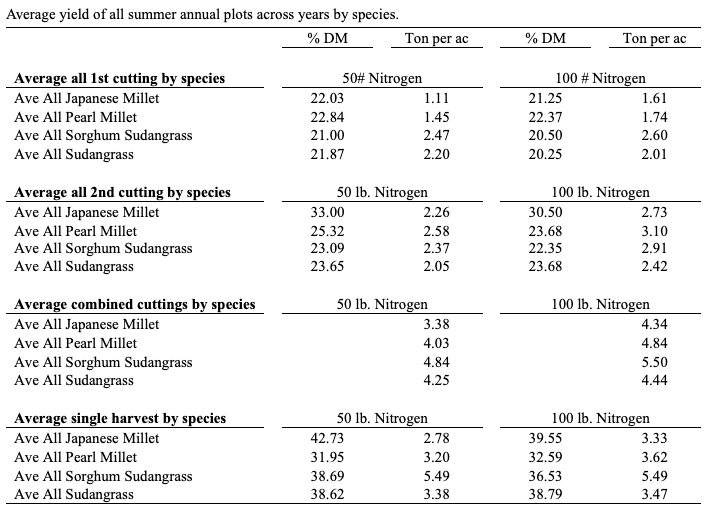Growing Beef Newsletter
June 2024, Volume 14, Issue 12
Annual Forages - Evaluating Production Potential in Northern Iowa Climate
Denise Schwab, ISU Extension and Outreach beef specialist
Cow numbers have declined, especially in the last five years. However, when we look over several decades, cow numbers are more consistent than the drastic decrease in pasture acres. This means cattlemen now are constantly seeking additional forage acres. Annual forages can help fill some of these forage needs, but the first step is to evaluate how much forage can be produced. This study was designed to evaluate annual forage production potential in a northern Iowa climate.
A winter annual/summer annual forage rotation was designed at the Northeast Iowa Research Farm at Nashua. Four winter annual varieties of cereal rye, winter wheat, and triticale were seeded in October 2020-2022 with 0 or 50 pounds of Nitrogen (N) fertilizer in April and harvested in late May. This was followed by four summer annual varieties (Japanese millet, pearl millet, sudangrass, sorghumXsudangrass) in May 2021-2023 with either 50 or 100# N fertilizer. The first 50# was applied at planting, and the additional 50# applied around first harvest. First harvest occurred in early August, with a second harvest in mid-September. Since this farm does not have cattle, all plots were mechanically harvested.
Rainfall was a major limiting factor in this study, especially in 2023. Dry conditions in the fall of 2020 and even more so in the 2022-23 season impacted seedling emergence and growth.

As expected, cereal rye was the first winter annual to break winter dormancy and yielded the most at 3.10 dry matter (DM) tons per acre with no nitrogen and 3.65 DM ton/ac at 50#N. It was also the most mature at harvest so the lowest in both crude protein and energy of the varieties tested. Winter wheat varieties were the last to break dormancy, so had the lowest yields at 2.45 ton/ac at 0N and 2.75 ton/ac at 50#N. Triticale was intermediate at 2.78 ton/ac at 0N and 3.14 ton/ac at 50#N.
From a feed quality standpoint, cereal rye tended to be the lowest in both crude protein and energy since it was the most mature, and 0N tended to be lower than 50#N treatments. Crude protein ranged from a low of 8% to a high of 21%, with the majority of samples meeting or exceeding the requirements for early lactation cows, while TDN levels were slightly below early lactation cow requirements.
In the summer annual trials, Japanese millet was only included in the first year. Its yields were lowest on the second harvest, and it appeared to require harvest more frequently than the other varieties. The initial intent of the project was to harvest the summer annuals twice and then rotate back to the winter annual. Within each plot, a section was left unharvested the first time to get a single-cut yield in September in addition to a two-cut system yield. The single-cut section was hand-harvested in September. In 2023, severe drought delayed and restricted germination, so much so, that only one late harvest was done in September.
The sorghumXsudangrass (SXS) tended to be the highest yielding with the pearl millet and sudangrass being similar but less than the SXS hybrid. The additional 50# N after first harvest tended to increase crude protein but had minimal impact on TDN. In general, the sudangrass and millets yielded more in the two-cutting system than the single harvest, and the SXS yielded more in the single-harvest system. The SXS had the highest yields overall regardless of harvest system. Also, all varieties realized a yield boost following the mid-season nitrogen application.

All first-cutting samples met or exceeded the crude protein and TDN requirements of mid-gestation cows. However, second cutting or a single September harvest samples were marginal or did not meet the crude protein and TDN requirements for late lactation cows. Given the plant maturity observed in the harvest intervals, this was expected.
In summary, a winter annual- summer annual forage rotation can be used to break up the traditional corn-soybean rotation and produce 7-10 tons per acre of forage biomass on a dry matter basis per year.
Thanks to the Iowa Beef Center mini-grant and the North Central Extension Risk Management Education supported by USDA/NIFA under Award Number 2018-70027-28586, for funding this project; Ken Pecinovsky at Northeast Research and Demonstration Farm for managing the plots; Welter Seed & Honey, Melbourne Seed, and Albert Lea Seed for donating seed; and Shelby Gruss for running the statistical analysis.
This monthly newsletter is free and provides timely information on topics that matter most to Iowa beef producers. You’re welcome to use information and articles from the newsletter - simply credit Iowa Beef Center.
